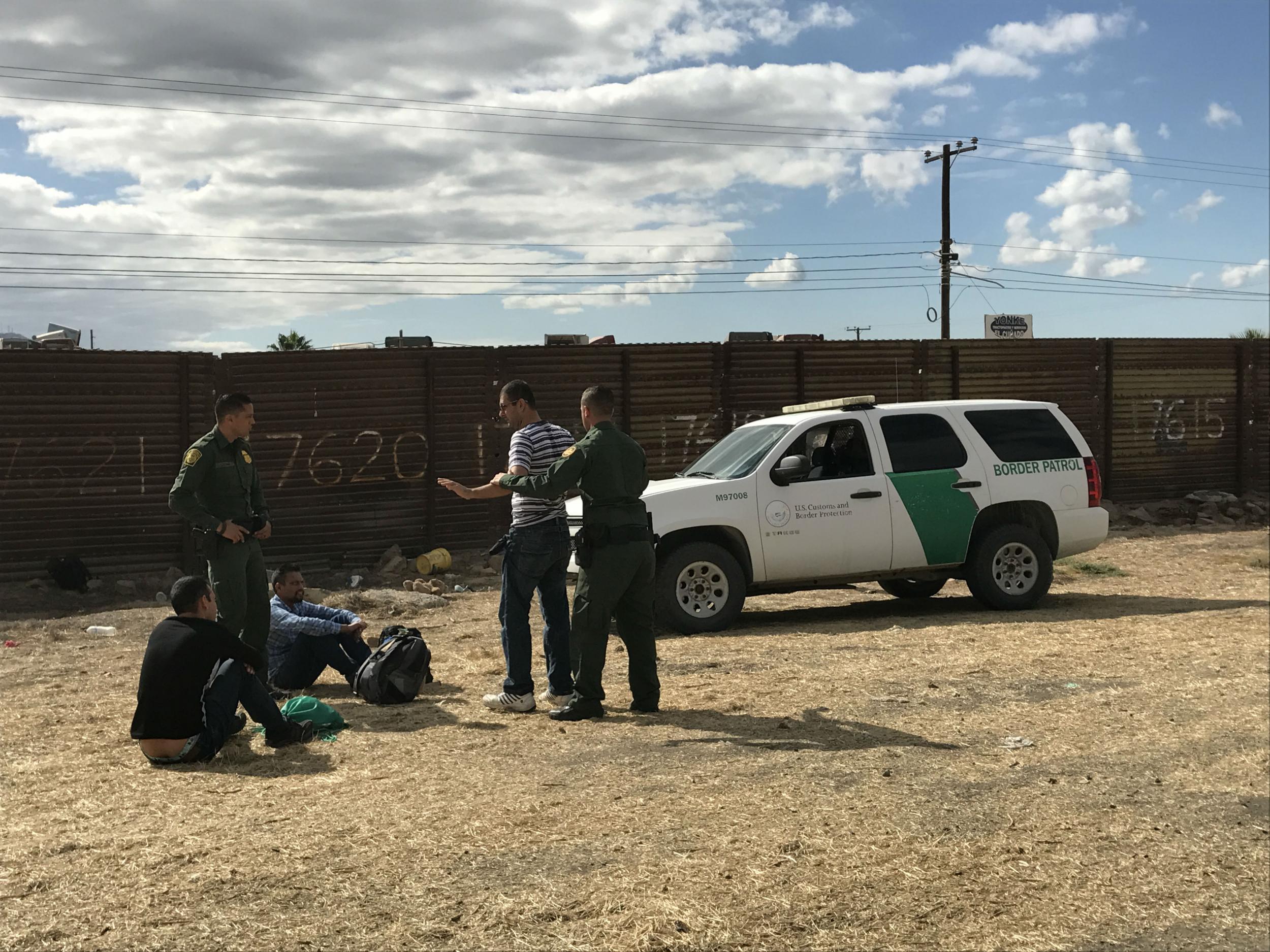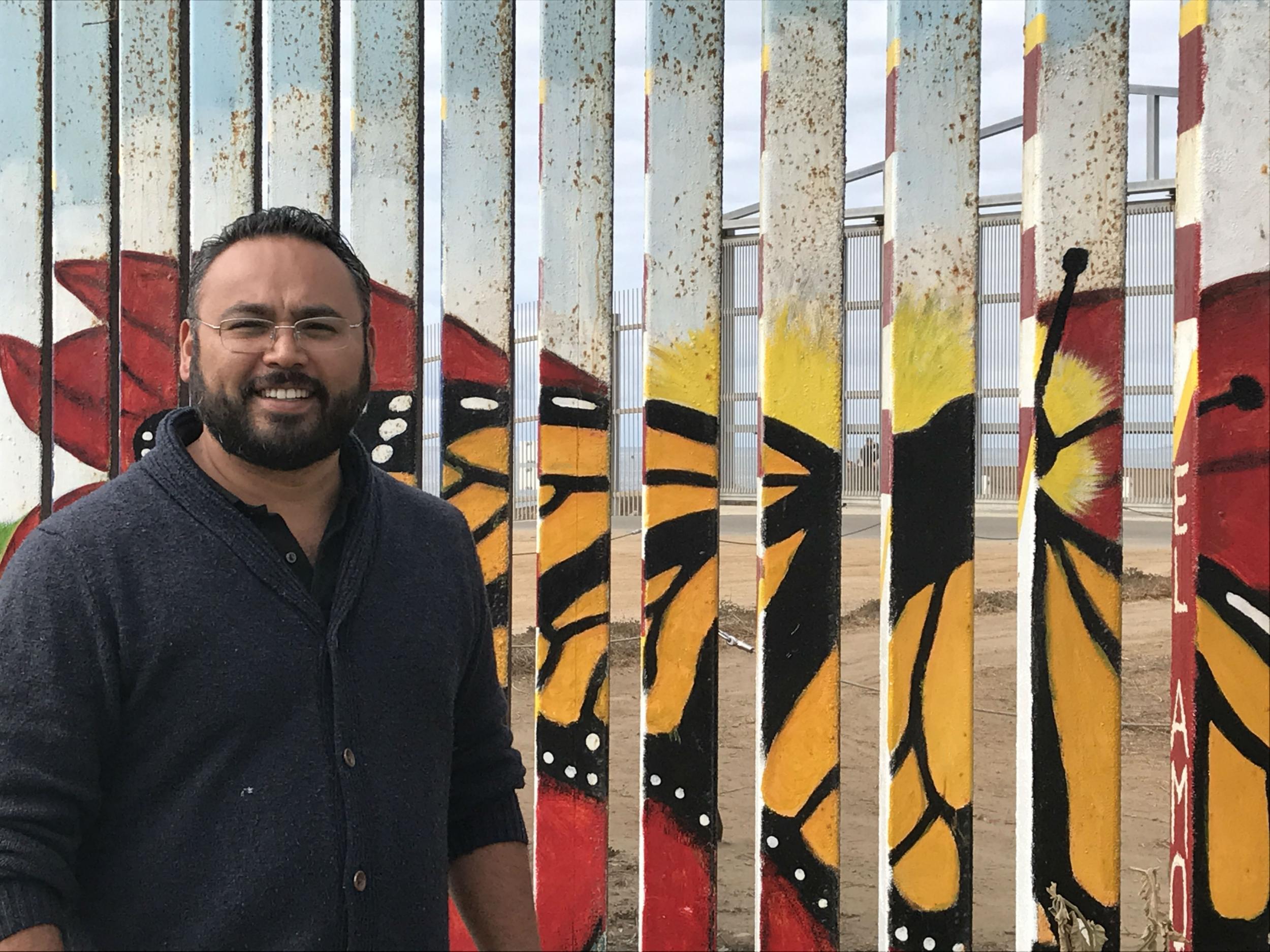Their bags crept over the wall, then their fingers: My chance encounter with immigrants at the US border
While inspecting prototypes for Trump’s notorious campaign promise, I encountered a family whose desperate situation will continue to outsize any wall
Your support helps us to tell the story
From reproductive rights to climate change to Big Tech, The Independent is on the ground when the story is developing. Whether it's investigating the financials of Elon Musk's pro-Trump PAC or producing our latest documentary, 'The A Word', which shines a light on the American women fighting for reproductive rights, we know how important it is to parse out the facts from the messaging.
At such a critical moment in US history, we need reporters on the ground. Your donation allows us to keep sending journalists to speak to both sides of the story.
The Independent is trusted by Americans across the entire political spectrum. And unlike many other quality news outlets, we choose not to lock Americans out of our reporting and analysis with paywalls. We believe quality journalism should be available to everyone, paid for by those who can afford it.
Your support makes all the difference.It might almost have been staged, a carefully choreographed breach right before our eyes – men and women scrambling over, bedraggled, even a small child – to convince us that President Donald Trump’s call for a bigger, better wall hadn’t just been a sop to the racist, xenophobic voter to get him elected. It was important. Look, you see, aha, here they come, the marauders.
We had barely arrived when it began, at the spot on the US-Mexican border just east of San Diego where eight prototypes of Trump’s promised new border wall had just sprung up. The mock-ups are dramatic all on their own, a sort of cruel, gap-toothed grin towards Tijuana on the other side, a dare to the smugglers and would-be migrants. Scale these if you can.
Foreboding to be sure, they’ll be tested soon, once the concrete is cured. The US Border Patrol will go at them with drills, sledgehammers, even flamethrowers. They will throw grapple hooks over the top and chip away with pickaxes underneath, just to see which withstands abuse the best. It is likely in the end they’ll opt for a hybrid of the prototypes they have now, combining their best elements, rejecting all else.
Agent Eduardo Olmos, escorting the reporter, was in the midst of explaining this. The walls they have now may look challenging but aren’t really. First, there’s a metal wall made of surplus helicopter pad from the Vietnam War that’s eight to 10 feet high. For about 13 miles running inland from the ocean, there’s also a secondary, much higher, metal fence. But it can be cut through. They patch about 10 holes every week.
Though an American now, Olmos is originally from Tijuana. Most of his family still live there. He admits there’s friction over what he does. And Trump. “It’s got very negative, very soon,” he says of the feelings of his relatives. When visiting he tries to keep off the topic. “We do have different opinions.” But he adds: “What I have seen here allows me to have proof of what we are doing – that it is the right thing for the country.” He means the US, of course, not Mexico.
“Back in the Eighties, you’d see it was actually out of control,” he insists. “Migrants would gather on the US side, there were only 500 agents then, it was unsafe for them to patrol. They would gather and there was a lot of rapes, murders, assaults, robberies and crime. It was chaos here.” His words echo those of Trump when he launched his presidential bid in 2015 about Mexico. “They’re bringing drugs. They’re bringing crime. They’re rapists.”
It is quieter now, Olmos contends, because of physical barriers erected since then and the higher numbers of agents. Yet, according to the Border Patrol, nearly 24,000 migrants were caught trying to enter the US illegally in the 60-mile San Diego sector alone just from January to August this year. For the 12 months of last year it was 31,891, and 415,816 for the US-Mexico border as a whole.

That our interview is suddenly interrupted isn’t so surprising then for them. The Trump prototypes stand exactly at the 13-mile marker where the secondary fence ends, theoretically a good location to make a break for America. First came the bags, tossed over to our side, a signal to the agents to switch to apprehension mode. Olmos and his colleague, Vincent Pirro, who’d also been on media assignment for the day, approach the wall but don’t get too close to avoid danger to themselves. For the same reason, they are forbidden to help when the bags’ owners appear.
Three men have made it over when I spy four grimy fingers hooking over the wall’s top. The last man in the group is hesitating, perhaps grasping that this wasn’t the best place to cross after all. His companions are already corralled by Olmos and Pirro, seated on the ground. Finally, he perches on the top for a few moments, letting out loud, incomprehensible groans of fear and panic. His bag gets snagged, but he frees it and finally he makes the leap himself, falling sideways and banging his head on a small rock. He is not hurt seriously. Moments later a young woman appears. She has a small boy with her. They too make it over, instantly to be arrested.
Little about Trump elicits more passion than his promise to “build the wall”. To his supporters, it’s the ultimate solution to the open-border travesty they see being at the root of everything wrong with their lives: drugs, crime, the evaporation of manufacturing jobs and the dilution of America as they understand it. To his detractors – Pope Francis joined the debate in the campaign calling it “not Christian” – it is a barely disguised tilt at the racist underbelly of America. If ever realised, it would not just stand as a raised middle finger to Mexico and the rest of the world but also threaten to steal grotesque sums from the public purse. Plus it wouldn’t work.
One year on, all he has to show for it are these eight, rude incisors in the San Diego desert. The question now hangs: will the real thing ever happen? Largely, that will be for Congress to decide. As a start, the White House’s draft 2018 budget seeks about $1.6bn (£1.2bn) to begin building at least some sections and replacing existing ones. It may get some of that, but deals will have to be cut. To build the entire wall, as much as $21bn would have to be found. But almost no one believes the wall as Trump originally evoked, stretching all 2,000 miles of the border, will ever happen, Agent Olmos included. Some of the terrain is simply too extreme to build on and, because of it, too extreme for migrants to successfully navigate.
But even short stretches would be welcomed by those on the front line of interdiction. “We will work with what we get,” Olmos averred. “This is a big step for border control and for border security. These prototypes are our future, not just the prototypes themselves but all the ideas they give us so we can upgrade and make our job a lot more efficient and a lot more effective.”

If Olmos attempts to drain the wall and the debate that surrounds it of all emotion, for Enrique Chiu, an artist living on the other side in Tijuana, the opposite is important. A painter, he too was moved by his family from Mexico to the US when he was young. But in 2000, he took an unlikely tack, moving back and settling in Tijuana to explore how the trauma of the border could be salved through art.
Late in 2016, Chiu was sure Hillary Clinton would win the election and he’d have the chance to do something to unite the two countries again, symbolically anyway. He would paint a mural on his side of the existing wall and American artists would paint the other. But then Trump won and he had to rethink. There would be nothing bi-national about his project any more, it would be on the Mexican side only. It would be lonely and hard, but the need to protest was more urgent.
Lonely, it hasn’t been. Showing off stretches of the original wall already decorated in smudged images of hearts, rainbows and other ephemera, he reports that every weekend since Trump’s election he has played host to artists – and would-be artists – from every corner of the world. Already about 2,600 people have travelled to Tijuana to help him. “People care right now about what is happening to Mexico and at the border, that’s why they’re coming from all countries to support this project.” He cites Germany, China, New Zealand and Japan in particular. “I pick them from the airport and they paint with me Friday and Saturday and I take them back to the airport on Sundays.” The less talented leave messages or simple outlines of their hands.

Called El Mural de la Hermandad – mural of brotherhood/sisterhood – it now runs along roughly three miles of wall in Juarez, almost into the ocean at its west end. Chiu has also been to other border cities, including Juarez, Mexicali and Tecate, to paint shorter, symbolic sections. Soon it may make a Guinness World Record as the biggest mural in the world. But that’s not what moves Chiu. He believes he is doing his own small part to protest the human tragedy that, in his mind, is the physical barrier dividing the two nations he has called home. “The wall, it was ugly, it was rusty, almost an emblem of Mexico. So, I said, let’s do something positive. This was our time to put our ideas, our expressions, our feelings on the wall.”
Those feelings towards Trump and his plans and prototypes for a new wall are, of course, not charitable. “It’s not logical, it’s not right what he is doing,” he says, using aerosol paint to touch up spots where rust is showing through. (Generally, he prefers to use a brush.) “Why does he want to spend that kind of money doing something that is not going to work anyway? People who really want to go to America, they are going to find a way.”
But he is also philosophical. Mexico has already made clear it will not pay for Trump’s wall, but this Mexican will paint it. The wall that’s there and the next one, if it comes. “I am using the wall like a canvas and if Trump builds another big wall like he says he will, I will paint it also,” he vows.
Back on the other side, Agent Olmos says he has vaguely heard of an artist in Mexico adorning the wall with art. It is technically American property, but he doesn’t know much about it and clearly cares less. “That’s the least of our worries.” And now he must finish bundling the wretched new arrivals, including the mother and boy, each one darkened by dust and dirt, into the Border Patrol van that has drawn up to collect them.
For Agent Pirro, the time to leave can’t come fast enough. “I just want to wash my hands,” he mutters heading for his jeep.

Join our commenting forum
Join thought-provoking conversations, follow other Independent readers and see their replies
Comments